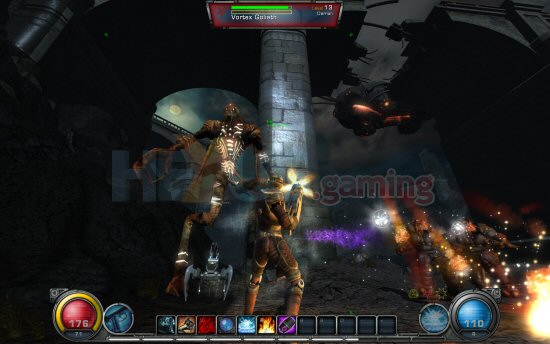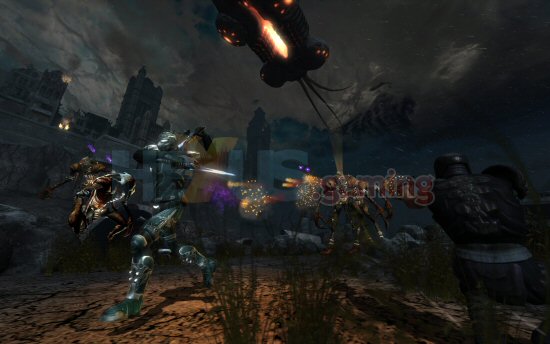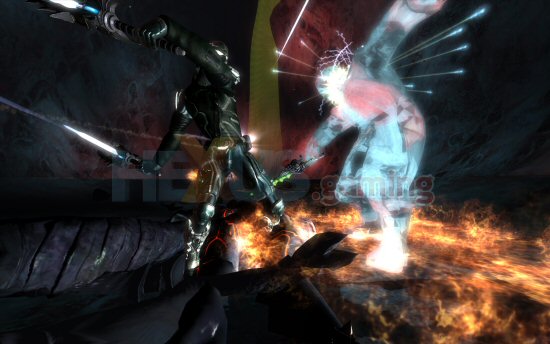Skills and inventory systems... one good, one bad.
The inventory system will be familiar to most RPG players in that it uses a slot-based system with items taking up a certain size and shape of slots. Rifles take up a 6 slots in a horizontal 3x2 rectangle whereas an armoured vest takes up the same space but upended… And this leads to the inevitable, infamous ‘inventory tile sliding game’ as you jiggle stuff around to squeeze in that enhanced rifle that’ll pick up a fair sum at the vendors back at base.Equipping your character is simplicity itself, you just drag and drop the item in question into the relevant slot on the inventory screen. Sensibly, if an item already occupies the slot, it’ll be automatically be swapped with the one you wanted to drop in. Further, you can’t equip items straight from the pick up, they have to go into your inventory first. This is actually very handy as not being able to autoswap within the inventory means you could end up having to drop something you wanted to keep… at least this way there’s always the space to put de-equipped items back.
 Click for larger image
Click for larger imageLevelling up is achieved through the usual means of killing bad guys and completing missions with each new level regenerating your health and power bars as well as giving you knew attribute and skill points to spend on improving your character. The skill tree in Hellgate: London is a single screen affair with a seemingly disparate range of icons dotted around, some of which are linked to each other in a vertical column. Depending on your class you’ll see a different set of skills, many of which are dependent on your character’s level but also have a range of levels within themselves.
As you battle your way from station to station, Oyster Card notwithstanding, you’ll gradually unlock more skills for your character and it’s using these skills at the right time that can make the difference between surviving or becoming monster chow chow. I have to admit that I’ve invested more time in the Marksman than any other class, it just seemed more fitting for a near(ish) future scenario and I have to say that the bombardment skill, where you just unleash a massive volley in the general direction of the enemy, is brilliant up to about level 5 and then after that each additional skill point makes less of an impact on the overall skill.
 Click for larger image
Click for larger imageBut this ‘diminishing returns’ system on the skills is actually quite a good idea. You see, rather than just keep chucking points at one skill to make it uber-powerful, you’re forced to spread you skills around. This makes you think more carefully about what to invest the points in. Should you level up an already acquired skill or invest a few points in a completely new skill? This lets you focus on skills you actually use in combat rather than forcing you to gain and invest in a skill just to unlock something better later. Sure, some skills are linked like that but you can just chuck one point in the base skill to gain access to the stuff higher up.
But it’s not just your character’s skills and attributes you can fiddle with, you can muck around with your weapons and armour too. Basic weapons are just that, basic, but even they come in different flavours, namely the mod slots for you to customize them as you go. Mods can range from techie stuff such as sniper scopes through to magical items such as relics which imbue a magical bonus of some sort to the weapon they’re attached to. Some weapons come with bonuses built in and will have more mod slots that others, but even basic weapons you find might yield useful base items if you break them down.
 Click for larger image
Click for larger imageThese bits, if you have the right amount of the right stuff, can be used at nanoforges in the stations to upgrade or enhance your weaponry. And as we all know, bigger and nastier means more dangerous… In addition to this mode of modding, weapons have mod slots which you can drop certain types of mods, providing the weapon has a suitable slot. The difference is, a Nanoforge fully integrates the parts into your weapon, whereas a mod slot allows the mod to be simply pulled out and swapped for another mod anytime you fancy…which is dead handy if you want to be effective against a wide range of baddies.









